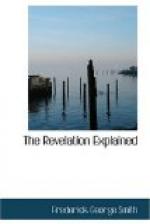14. For they are the
spirits of devils, working miracles, which
go forth unto the kings of
the earth and of the whole world, to
gather them to the battle
of that great day of God Almighty.
15. Behold, I come as
a thief. Blessed is he that watcheth, and
keepeth his garments, lest
he walk naked, and they see his
shame.
16. And he gathered them
together into a place called in the
Hebrew tongue Armageddon.
The symbols under this vial are so different that at first they scarcely look like anything constituting a plague. By recalling a few circumstances of history we shall understand why the river Euphrates was selected as a symbol, and also, its true signification in this connection. This river was connected with ancient Babylon, and while running in its own channel was the protection of the city and an obstacle to its capture. By turning the water of this river from its course, King Cyrus (according to the account given by Herodotus) succeeded in overthrowing the city, with the result that God’s people who were at that time in captivity there received permission to return to their own land and to rebuild the house of God in Jerusalem. Ezra 1:1-3. Under the sixth trumpet this symbol was applied to the four angels as a symbol of the restraint placed upon their operations, they being bound in that river. As there are no agents in this vision who are represented as bound, we must apply it to the city itself, the name of which is given in verse 19—Babylon—being a symbol of one of its defenses. According to verse 19 this mystical Babylon is composed of three parts, being made up of the dragon (in his modern form), the beast, and the false prophet mentioned in verse 13. And its location is not confined to the territory of the ten kingdoms; for its field of operations is not only that of the “earth”—the Apocalyptic earth—but “of the whole world.” Ver. 14. In one division of this great city, that of the false prophet, God’s people were long held in captivity; but its spiritual overthrow was to be accomplished by the drying up of the Euphrates of its defenses, that the way of the kings of the East might be prepared.[12]
[Footnote 12: Applying the Euphrates (an object from nature) as a symbol of ecclesiastical affairs in this manner appears to be in violation of the laws of symbolic language laid down; but we should bear in mind the fact that events of whatever nature connected with the history of God’s chosen people in the old dispensation are of themselves proper symbols of similar events in the New Testament dispensation. Thus the temple, altar, candle-sticks, incense, holy city, etc., of the former dispensation, although of themselves objects from nature, are nevertheless clearly used to represent affairs of the church, because of their former significance as connected with the people of God. The fact that the great city of this chapter is spiritual Babylon (see verse 19) is positive proof that the river Euphrates is here applied in the proper manner.]




